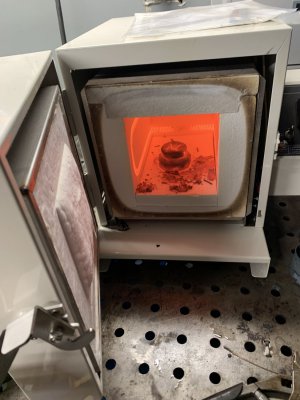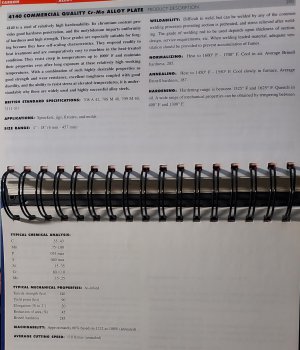Anything “free machining” will behave much better. Known alloy , correct cutting tools and with in your machines limits ….. all needs to be taken in. Im very new but everyday at the lathe things improve.I’m new to the hobby. I see lots of reference to different steel specs, clearly the choice of material is dependent on the duty it needs to perforrm, but right now I’m just trying to get good surface finish and turn accurate diameters so what are the easier grades to turn? I’m also using brass and aluminum
-
Welcome back Guest! Did you know you can mentor other members here at H-M? If not, please check out our Relaunch of Hobby Machinist Mentoring Program!
You are using an out of date browser. It may not display this or other websites correctly.
You should upgrade or use an alternative browser.
You should upgrade or use an alternative browser.
How big of a cut 9x20 import
- Thread starter durableoreo
- Start date
- Joined
- Apr 23, 2013
- Messages
- 1,004
I have been machining for 70 years. On a low horse powered machine the first thing I do is go to a very high positive cutting tool. I don’t care if it is hss or carbide. I qqoften use a tool with as much positive back rake as 45 degrees.
My Logan can cut 1/4 inch cut on c12l15.
My Logan can cut 1/4 inch cut on c12l15.
- Joined
- May 3, 2020
- Messages
- 229
I forgot to mention that I'm working with annealed 4140.
My understanding is that 4140 is a free cutting alloy. I'm using it because I'm making sockets that will be used by gorillas with 3/4" impact drivers. I'm not making fun of anyone but it is a challenge to make parts that survive "in the field". The sockets will be heat treated, tempered, and tested after I slog though all this machining. There may be some other alloy that would work but 4140 is fairly available and meets the requirements. There may be a better choice of materials and I'm open to suggestions. Using 12L14, however, will probably not work in this application because case hardening won't produce the toughness needed.
Here's a charge of machinability. 12L14 is 170%---so easy. Annealed 4140 is 66%. O-1 is 41%. Aluminum is 360%. https://www.machiningdoctor.com/machinability/ https://www.cnclathing.com/guide/cn...chinability-of-metals-and-plastics-cnclathing
@Ischgl99 RE: regidity, I'm running a fixed tool post. The cross slide ways are scraped, gib is tightly fitted, and the carriage is scraped to the ways. I am getting some chatter but I can FEEL the vibration in the headstock but not the cross slide. I think the bearings are the cause of the problem.
@mac1911 I'll clean up the belts and see if I can get a little more power at the cutting tool.
@markba633csi Maybe I'll set up a mist coolant system.
My understanding is that 4140 is a free cutting alloy. I'm using it because I'm making sockets that will be used by gorillas with 3/4" impact drivers. I'm not making fun of anyone but it is a challenge to make parts that survive "in the field". The sockets will be heat treated, tempered, and tested after I slog though all this machining. There may be some other alloy that would work but 4140 is fairly available and meets the requirements. There may be a better choice of materials and I'm open to suggestions. Using 12L14, however, will probably not work in this application because case hardening won't produce the toughness needed.
Here's a charge of machinability. 12L14 is 170%---so easy. Annealed 4140 is 66%. O-1 is 41%. Aluminum is 360%. https://www.machiningdoctor.com/machinability/ https://www.cnclathing.com/guide/cn...chinability-of-metals-and-plastics-cnclathing
@Ischgl99 RE: regidity, I'm running a fixed tool post. The cross slide ways are scraped, gib is tightly fitted, and the carriage is scraped to the ways. I am getting some chatter but I can FEEL the vibration in the headstock but not the cross slide. I think the bearings are the cause of the problem.
@mac1911 I'll clean up the belts and see if I can get a little more power at the cutting tool.
@markba633csi Maybe I'll set up a mist coolant system.
Clean the begeez out of the pulleys and get new belts.
I will add only because of my lack of alloy knowledge ( its getting better) that the machinability is not as limiting as the limiting power of the small machines.
My thoughts are use material that meets the specs you need
12L14 from what I know so far does not weld nice and does not heat treat well ?
Are you doing the heat treating yourself?
I will add only because of my lack of alloy knowledge ( its getting better) that the machinability is not as limiting as the limiting power of the small machines.
My thoughts are use material that meets the specs you need
12L14 from what I know so far does not weld nice and does not heat treat well ?
Are you doing the heat treating yourself?
Last edited:
The limited experience I’ve had with annealed 4140 was very pleasant with my 11” 1 HP machine. It machined much easier than I expected. The chips were very hot and went everywhere, though. I used an ISCAR DCMT21.51 insert. At the finishing speed the finish was beautiful. The IC907 version of that insert is intended for lower speeds on hard steel and will take shallow cuts better than many carbide inserts. I’ve found that to be true regardless of the alloy.
- Joined
- Dec 18, 2022
- Messages
- 1,675
I like 1018 and 1045 for general use and A36 when I need down and dirty cheep. I get good finishes cutting 1045, 1018 cuts good for me but the finish isn't awesome and A36 is like cutting bubble gum. I have some 4140, A1 and O1 but they are expensive so I save them for items which require them. Stefan Gotteswinter has a good YouTube channel I follow and he recommended a book which was originally printed in German and the English version is "Mechanical and Metal Trades Handbook" which I bought a copy of and it has a good section on materials; actually, I find the entire book is extremely useful and it works well for those just getting started, the only caveat is it is metric.....I’m new to the hobby. I see lots of reference to different steel specs, clearly the choice of material is dependent on the duty it needs to perforrm, but right now I’m just trying to get good surface finish and turn accurate diameters so what are the easier grades to turn? I’m also using brass and aluminum
- Joined
- Jan 4, 2024
- Messages
- 22
Thank you, I’ll check it outI like 1018 and 1045 for general use and A36 when I need down and dirty cheep. I get good finishes cutting 1045, 1018 cuts good for me but the finish isn't awesome and A36 is like cutting bubble gum. I have some 4140, A1 and O1 but they are expensive so I save them for items which require them. Stefan Gotteswinter has a good YouTube channel I follow and he recommended a book which was originally printed in German and the English version is "Mechanical and Metal Trades Handbook" which I bought a copy of and it has a good section on materials; actually, I find the entire book is extremely useful and it works well for those just getting started, the only caveat is it is metric.....
- Joined
- May 3, 2020
- Messages
- 229
12L14 from what I know so far does not weld nice and does not heat treat well ?
Are you doing the heat treating yourself?
I think 12L14 case hardens well enough. But it's a relatively low carbon alloy (14% IIRC), so it won't harden through.
Yes, I'm doing the heat treatment and hardness testing. All of these sockets have passed "inspection", so heat treatment is the fun part of the project. The recipe is 1600 oF for 1 hour, quench in medium oil (Parks AAA in this case), and draw at 825 oF for 2 hours. Then sand blast, another round of inspection, and black oxide. I have the Caswell kit which is just a dunk. Previously I've used the stuff from McMaster which is a paint-on gel. I think Mr Bar-Z uses that stuff on his mini squares.

- Joined
- May 3, 2020
- Messages
- 229
The limited experience I’ve had with annealed 4140 was very pleasant with my 11” 1 HP machine. It machined much easier than I expected. The chips were very hot and went everywhere, though. I used an ISCAR DCMT21.51 insert. At the finishing speed the finish was beautiful. The IC907 version of that insert is intended for lower speeds on hard steel and will take shallow cuts better than many carbide inserts. I’ve found that to be true regardless of the alloy.
Thanks for the insert. I know people like HSS but it's good to know about inserts, too. Looks like highly positive geometry. Here's a picture:
- Joined
- Dec 18, 2022
- Messages
- 1,675
12L15 doesn't harden well because of the lead in it which is the L portion.... My books say Not considered case hardening steel.I think 12L14 case hardens well enough. But it's a relatively low carbon alloy (14% IIRC), so it won't harden through.
Yes, I'm doing the heat treatment and hardness testing. All of these sockets have passed "inspection", so heat treatment is the fun part of the project. The recipe is 1600 oF for 1 hour, quench in medium oil (Parks AAA in this case), and draw at 825 oF for 2 hours. Then sand blast, another round of inspection, and black oxide. I have the Caswell kit which is just a dunk. Previously I've used the stuff from McMaster which is a paint-on gel. I think Mr Bar-Z uses that stuff on his mini squares.
View attachment 473614
Just an FYI, the book says Cutting speed for this material is between 110 Ft/min Annealed.


